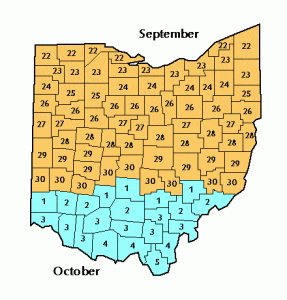 As harvest approaches, its time to check our corn plants for stalk integrity. Time spent tin the field now, may pay huge dividends later this fall. As stalk tissue becomes compromised below the main ear the stalk may become brittle or weak and be prone to lodging.
As harvest approaches, its time to check our corn plants for stalk integrity. Time spent tin the field now, may pay huge dividends later this fall. As stalk tissue becomes compromised below the main ear the stalk may become brittle or weak and be prone to lodging.
There are a number of plant pathogens that can cause stalk rot including, Anthracnose, Bacteria, Charcoal, Diplodia, Fusarium, Gibberella, and Pythium. Some of these stalk rots have very characteristic symptoms that can help identify the specific problem, while others may require laboratory diagnosis (Table 1). The Purdue Extension Publication Corn Diseases: Stalk Rot has good images to help identify the major stalk rot diseases. (https://www.extension.purdue.edu/extmedia/BP/BP-89-W.pdf ).
Check field by using the Push or Pinch Test by evaluating 20 plants in at least five random areas in a field.
- Pinch Test – grab the stalk somewhere between the lowest two internodes and pinch between your fingers to see if the stalk is strong enough to handle the force – if the stalk collapses, it fails.
- Push Test – push the stalk to a 30-degree angle – if it pops back up when released, it passes the test, if not it fails.
Threshold: 10% or more of the stalks fail then consider field for early harvesting to avoid risk for lodging.
What can you do in the future – management options will depend on the specific disease (see table 1). Production practices that promote good plant health including balanced fertilization, appropriate plant populations, and good water management can reduce stresses that might predispose corn to stalk rot. In addition, these key management tools can help mitigate future stalk rot issues.
- Properly diagnosis the stalk rot pathogen.
- Select hybrids with resistance if available.
- Crop Rotation – rotating to non-host crop will help reduce stalk rot potential in a field. Note that Charcoal rot and Gibberella stalk rot can infect other rotational crops.
- Tillage – burying infected crop residue will encourage more rapid desiccation and help reduces risk of overwintering in crop residue.
- Good soil drainage and reduced compaction.
- Foliar Fungicides – applying foliar fungicides can help protect crop from foliar diseases that could predispose plant to stalk rot when present, but devoid of foliar disease pressure fungicides applications have not consistently been found to help reduce stalk rot.




 Harvest season is right around the corner. As we all know this time of year can be very busy with many different activities happening at once. Try to keep safety in mind especially around grain handling equipment. There are many potential hazards to consider when handling grain, such as equipment entanglement, grain entrapment and engulfment, dust explosions, among others.
Harvest season is right around the corner. As we all know this time of year can be very busy with many different activities happening at once. Try to keep safety in mind especially around grain handling equipment. There are many potential hazards to consider when handling grain, such as equipment entanglement, grain entrapment and engulfment, dust explosions, among others.









